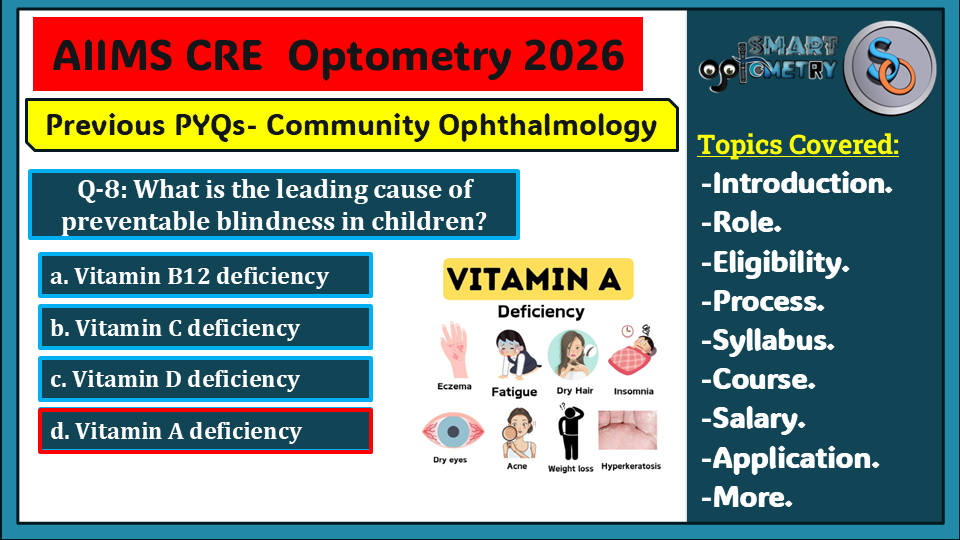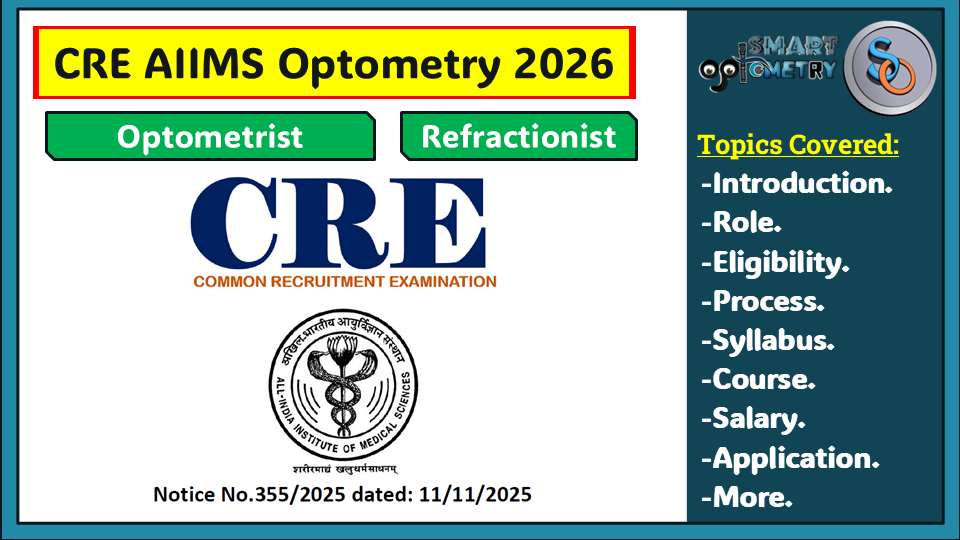Q-1: ______ is a system of collection of corneas/eyeballs from cadaveric or brain-dead persons. (AIIMS Previous Year MCQs- Community Ophthalmology)
a. Eye banking
b. Staffing
c. Eye retrieval
d. Eye training
Click “Show more” to see the answer and explanation.
The correct answer is A. Eye banking.
Explanation: Eye banking is the organized system responsible for the harvesting, processing, and storage of corneal tissue from deceased donors. This infrastructure is critical for facilitating corneal transplantation and restoring vision to patients with corneal blindness.
Struggling with your optometry government job preparation? Let Samir Sir, the founder of Smart Optometry, guide you to success. Enroll in our “Gov Job Preparation” course, and we’ll provide the roadmap. Your dream job at GSSSB, AIIMS, RRB, or DHS is within reach!
.
.
Q-2: _______ initiative offers a good opportunity to develop a comprehensive eye care programme with strong commitments at all levels. (AIIMS Previous Year MCQs- Community Ophthalmology)
a. Vision 2020
b. District Blindness Control Society
c. Low Vision
d. State Ophthalmic Cell
Click “Show more” to see the answer and explanation.
The correct answer is A. Vision 2020.
Explanation: “Vision 2020: The Right to Sight” is a global initiative by the WHO and IAPB to eliminate avoidable blindness. It provides a strategic framework for developing comprehensive eye care systems and human resources at every level of healthcare.
.
.
Q-3: Which of the following is an objective of the National Programme for Control of Blindness in India? (AIIMS Previous Year MCQs- Community Ophthalmology)AIIMS Previous Year MCQs)
I. Extension of eye care services
II. Establishment of an apex
a. Only I
b. Both I and II
c. Neither I nor II
d. Only II
Click “Show more” to see the answer and explanation.
The correct answer is B. Both 1 and 2.
Explanation: The National Programme for Control of Blindness aims to extend eye care services to peripheral, underserved areas and establish apex centers of excellence. These objectives ensure a robust infrastructure that covers both primary screening and advanced tertiary care.
Unlock your potential with our “Gov Job Preparation” course. Gain access to a massive library of 5000+ subject-wise MCQs, 1000+ previous year questions, detailed notes, and video lectures. Everything you need for exams like GSSSB, PSC, and DMER is in one place.
.
.
Q-4: In Vision 2020, which of the following is NOT a strategy or activity? (AIIMS Previous Year MCQs- Community Ophthalmology)
a. Cataract
b. Glaucoma
c. Diabetic Retinopathy
d. Ophthalmological science
Click “Show more” to see the answer and explanation.
The correct answer is D. Ophthalmological science.
Explanation: Vision 2020 focuses on targeted disease control strategies for specific causes of blindness like cataract, refractive errors, and trachoma. “Ophthalmological science” represents the broad academic field rather than a specific intervention strategy within the initiative.
.
.
Q-5: What year was the National Programme for Control of Blindness & Visual Impairment (NPCBVI) launched? (AIIMS Previous Year MCQs- Community Ophthalmology)
a. 1976
b. 1986
c. 1996
d. 2006
Click “Show more” to see the answer and explanation.
The correct answer is A. 1976.
Explanation: The National Programme for Control of Blindness was launched by the Government of India in 1976 as a 100% centrally sponsored scheme. It holds the distinction of being the first national program in the world specifically dedicated to blindness control.
Prepare for a full year of opportunities! Our “Gov Job Preparation” course gives you 12 months of access to top-quality materials and support. Cover all major exams like GSSSB, AIIMS, RRB, Ophthalmic Officer without buying multiple courses. It’s the smartest investment for your career.
.
.
Q-6: Which of the following conditions is not associated with vitamin A deficiency? (AIIMS Previous Year MCQs- Community Ophthalmology)
a. Nyctalopia
b. Xerophthalmia
c. Keratomalacia
d. Wernicke Encephalopathy (WE)
Click “Show more” to see the answer and explanation.
Answer is D. Wernicke Encephalopathy.
Explanation: Wernicke Encephalopathy is an acute neurological condition caused specifically by a deficiency in thiamine (Vitamin B1), not Vitamin A. Conversely, nyctalopia (night blindness) and xerophthalmia are classic ocular manifestations of Vitamin A deficiency.
.
.
Q-7: Which of the following conditions can be identified through pediatric vision screening? (AIIMS Previous Year MCQs- Community Ophthalmology)
a. Amblyopia
b. Hearing loss
c. Dental cavities
d. Allergies
Click “Show more” to see the answer and explanation.
The correct answer is A. Amblyopia.
Explanation: Pediatric vision screening is crucial for the early detection of amblyopia, or “lazy eye,” a neurodevelopmental disorder of vision. Early identification allows for timely interventions, such as occlusion therapy, which can permanently restore visual potential.
Don’t study alone! Our “Gov Job Preparation” course includes group chat and live support to clear all your doubts instantly. With guidance from Samir Sir and a community of fellow aspirants, you’ll stay motivated and on track.
.
.
Q-8: What is the leading cause of preventable blindness in children? (AIIMS Previous Year MCQs- Community Ophthalmology)
a. Vitamin B12 deficiency
b. Vitamin C deficiency
c. Vitamin D deficiency
d. Vitamin A deficiency
Click “Show more” to see the answer and explanation.
The correct answer is D. Vitamin A deficiency.
Explanation: Vitamin A deficiency is recognized globally as the single most important cause of preventable childhood blindness. It leads to xerophthalmia, which can progress to corneal ulceration and irreversible necrosis (keratomalacia) if left untreated.
.
.
Q-9: A premature baby weighing 1000 gms or less is most likely to suffer from: (AIIMS Previous Year MCQs- Community Ophthalmology)
a. Cataract
b. Glaucoma
c. Retinopathy of prematurity
d. Retinal detachment
Click “Show more” to see the answer and explanation.
The correct answer is C. Retinopathy of prematurity.
Explanation: Extremely low birth weight infants less than 1000 grams are at high risk for Retinopathy of Prematurity, a Vaso proliferative disorder of the developing retina. Without timely screening and laser treatment, this condition can lead to total retinal detachment and permanent blindness.
.
Ready to secure your government job in optometry? The “Gov Job Preparation” course is your final destination. With a proven success strategy, expert mentorship, and over 6000 MCQs, we make your preparation seamless and effective. Click the link to begin your journey!
.
Q-10: Which of the following is the output indicator of NPCB? (AIIMS Previous Year MCQs- Community Ophthalmology)
a. Number of cataract surgeries leading to sight restoration
b. Decrease in the prevalence of blindness
c. Number of schoolchildren provided with glasses for refractive correction
d. Number of eye surgeons trained
Click “Show more” to see the answer and explanation.
The correct answer is A. Number of cataract surgeries leading to sight restoration.
Explanation: The number of cataract surgeries performed is a primary output indicator for the NPCB, measuring the direct volume of service delivery. While prevalence reduction is an outcome, surgical volume tracks the immediate productivity of the program.
.
.
Q-11: What is the main objective of the National Programme for Control of Blindness & Visual Impairment (NPCBVI)? (AIIMS Previous Year MCQs- Community Ophthalmology)
a. To provide financial support for eye surgeries
b. To promote eye care awareness in the general population
c. To reduce the prevalence of blindness and visual impairment
d. To establish eye care centres in rural areas
Click “Show more” to see the answer and explanation.
The correct answer is C. To reduce the prevalence of blindness and visual impairment.
Explanation: The overarching objective of the National Programme for Control of Blindness & visual impairment is to significantly reduce the prevalence of blindness and visual impairment in the population. This is achieved through developing eye care infrastructure, human resources, and comprehensive service delivery.
Struggling with your optometry government job preparation? Let Samir Sir, the founder of Smart Optometry, guide you to success. Enroll in our “Gov Job Preparation” course, and we’ll provide the roadmap. Your dream job at GSSSB, AIIMS, RRB, or DHS is within reach!
.
.
Q-12: Changes seen in the conjunctiva in vitamin A deficiency: (AIIMS Previous Year MCQs- Community Ophthalmology)
a. Actinic degeneration
b. Hyperplasia of goblet cells
c. Hyperkeratosis of the squamous epithelium
d. Stromal infiltration
Click “Show more” to see the answer and explanation.
The correct answer is C. Hyperkeratosis of the squamous epithelium.
Explanation: Vitamin A is essential for maintaining epithelial integrity; its deficiency leads to squamous metaplasia and the loss of mucus-secreting goblet cells. This results in hyperkeratosis of the conjunctival epithelium, clinically manifesting as dry, keratinized plaques known as Bitot’s spots.
.
.
Prepare for a full year of opportunities! Our “Gov Job Preparation” course gives you 12 months of access to top-quality materials and support. Cover all major exams like GSSSB, AIIMS, RRB, Ophthalmic Officer without buying multiple courses. It’s the smartest investment for your career.
.
Are you preparing for the AIIMS Ophthalmic Assistant exam or other optometry government jobs? 🇮🇳 This blog breaks down the most important Community Ophthalmology MCQs from previous AIIMS exam papers.
We will solve and explain each question in detail, helping you understand the core concepts needed to clear your exam. 🧑🏫 This blog is essential for any optometrist or optometry student targeting government jobs.
🎯 Enroll in Our “Gov Job Preparation” Course! 🎯
Get complete, structured preparation for all optometry government exams (AIIMS, RRB, DHS, GSSSB, DMER, etc.) on our app.
🔗 Course Link: https://osvlt.on-app.in/app/oc/624036/osvlt?utm_source%3Dcopy-link%26utm_medium%3Dtutor-course-referral%26utm_campaign%3Dcourse-overview-app
📚 Download Our App: “Optometry Notes and MCQs” 📚
Access mock tests, previous year papers, video lectures, and detailed notes.
🔗 App Link: https://play.google.com/store/apps/details?id=co.robin.osvlt
📝 In This Blog, We Cover:
This session focuses on key Community Ophthalmology topics that frequently appear in AIIMS and other paramedical exams.
Topics Covered Include:
✅ Eye Banking & Corneal Retrieval Systems
✅ Vision 2020: The Right to Sight Initiative
✅ National Programme for Control of Blindness (NPCB) Objectives
✅ Important Launch Dates (e.g., NPCBVI – 1976)
✅ Pediatric Vision Screening & Amblyopia (Lazy Eye)
✅ Vitamin A Deficiency: Xerophthalmia, Bitot’s Spots, Keratomalacia
✅ Retinopathy of Prematurity (ROP) in low birth weight infants
✅ Leading causes of preventable blindness in children
This Blog is highly beneficial for aspirants of:
🧑⚕️ AIIMS Ophthalmic Assistant / Optometrist
🧑⚕️ Ophthalmic Officer (DHS, PSC)
🧑⚕️ GSSSB, DMER, UPSSSC Ophthalmic Officer
🧑⚕️ RRB Optometrist / Paramedical Exams
.
- Check Our Courses: Ophthalmic Instrumentation, Clinical Refraction, Contact Lens, Binocular Vision, Dispensing Optics, MCQs in Optometry
- Download our App “Optometry Notes & MCQs” from Google Play Store.
.




